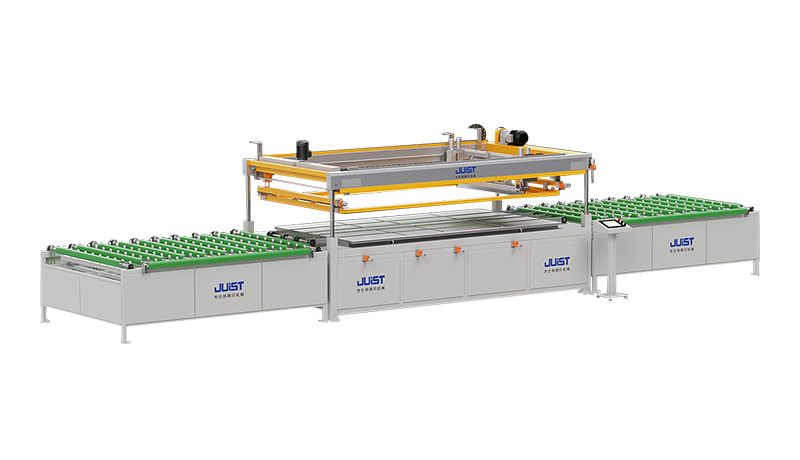+86-519-83387581
Precision Transformation Beyond the Manual Era
The traditional glass printing process is undergoing a historic leap from manual operation to full automation. The high-precision servo system replaces the hand experience of the craftsman, and the trajectory repeatability of the six-axis robot arm reaches ±0.02 mm, which is equivalent to one-third of the diameter of a human hair. The digital control system quantifies all key parameters such as screen tension, scraper angle and printing pressure, so that each batch of products can maintain absolutely consistent printing quality. This transformation not only improves production efficiency, but also makes large-scale replication of complex patterns possible, bringing new design freedom to the building curtain wall and consumer electronics industries.
Precision Concerto of Mechanical Intelligence
The modern automatic glass printing machine is like a precision symphony orchestra, and each component shows amazing collaborative wisdom. The linear motor-driven scraper system can achieve high-frequency reciprocating motion 5 times per second, and the pressure control accuracy reaches 10 grams. The adaptive screen tension mechanism can compensate for the deformation caused by material fatigue in real time, ensuring that the pattern is still accurate after millions of prints. The most eye-catching is the visual positioning system equipped with a deep learning algorithm, which can complete the alignment correction of complex patterns within 0.3 seconds, and even curved glass can achieve perfect overprinting.
Molecular Revolution of Functional Materials
The breakthrough development of special inks has given glass printing a new dimension. The innovation of UV curing system has shortened the curing time from minutes to seconds, while reducing energy consumption by 70%. Intelligent ink with temperature memory function can automatically adjust the transmittance according to the ambient temperature, realizing passive temperature control of architectural glass. More noteworthy is the development of conductive ink field. Silver-copper composite nanomaterials can form highly conductive paths at low temperatures through a special sintering process, with a resistivity of up to 5×10-6Ω·cm, which fully meets the application requirements of automotive electronics and smart buildings.
Intelligent Evolution of Building Skin
Automatic printing technology is redefining the functional boundaries of architectural glass. The printing accuracy of the conductive grid lines of photovoltaic curtain walls has been improved to 50 microns, which increases the photoelectric conversion efficiency by 15%. The circuit printing of electrochromic glass adopts an invisible design, which achieves rapid response while maintaining transparency. In the field of cultural heritage protection, high-fidelity printing technology can perfectly reproduce historical patterns and allow modern buildings to continue traditional aesthetics. These applications prove that printing technology has evolved from a simple decorative process to a core technology for architectural functional integration.
Quality commitment under the test of time
The rigorous environmental testing system ensures that printed glass products can withstand the test of time. The QUV3000-hour accelerated aging test verifies the color stability of inks under extreme ultraviolet rays. The high temperature and high humidity test of 85℃/85%RH simulates the tropical marine climate and tests the durability of the material interface. The chemical reagent test covers daily contact scenarios such as acid and alkali solutions and solvent wiping to ensure that the printed layer can remain in perfect condition under various environments. These test standards provide reliable quality assurance for glass printing products.
Smart factory driven by digital twins
In the future, glass printing workshops will achieve full-process digital management. The MES system monitors the operating status of each device in real time, and the automatic optimization algorithm of process parameters continuously improves production efficiency. The digital label system establishes a complete production file for each piece of glass to achieve accurate traceability of quality problems. The energy consumption monitoring platform can accurately measure the power consumption of each work unit, providing data support for green production. This intelligent transformation not only improves operational efficiency, but also creates a new model of flexible production.
Sustainable Practice of Green Manufacturing
Environmental innovation is reshaping the face of the glass printing industry. The water-based ink system reduces VOC emissions to almost zero, and the UV-LED curing technology saves 90% of the energy consumption of the traditional drying process. The screen laser regeneration system extends the service life of the mold by 8-10 times and significantly reduces solid waste. The closed-loop water treatment system realizes the recycling of industrial water and reduces the overall water consumption by 60%. These technological advances prove that precision manufacturing and sustainable development can be perfectly unified.









